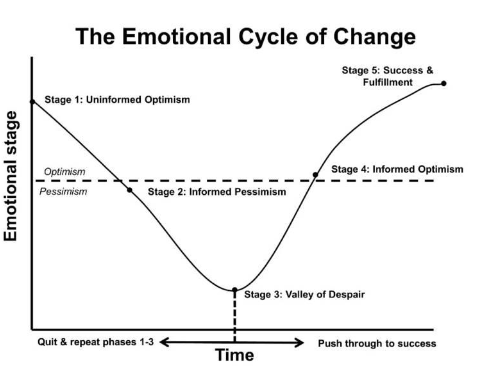The Emotional Cycle of Change is a framework adapted from psychologists Don Kelley and Daryl Connor that helps individuals and organizations navigate the emotional aspects of change. This model identifies five stages that people typically go through when changing their behavior, whether in personal or professional contexts. AND these stages are PREDICTABLE!

Five Stages of the Emotional Cycle of Change:
#1 - Uninformed Optimism:
- This is the initial and most exciting stage, where you are enthusiastic about the change because you focus on the potential benefits without fully understanding the costs. The emotions here are largely positive, fueled by ideas and strategies for the future.

#2 - Informed Pessimism:
- As the reality of what it takes to change sets in, enthusiasm wanes, and pessimism begins to grow. The costs of change become more apparent, and the benefits seem less significant. Doubts arise about whether the change is worth the effort.

#3 - Valley of Despair:
- This is the lowest point in the cycle. The challenges of change feel overwhelming, and the benefits seem distant. Many people give up at this stage, preferring the comfort of the status quo. However, perseverance through this stage is crucial to progress.

#4 - Informed Optimism:
- After enduring the valley of despair, you start to see the benefits of your efforts. The emotional state improves as the cost of change appears justified. Optimism returns, now informed by the reality of the situation.

#5 - Success and Fulfillment:
- In this final stage, the new behaviors or changes are fully integrated, and the benefits are clear. The initial difficulties are seen as worthwhile, and what was once challenging becomes routine.

Final Thought:
Understanding this emotional cycle helps normalize the range of emotions experienced during change, allowing individuals and organizations to navigate transitions more effectively without being derailed by temporary setbacks. Embracing this cycle can significantly increase the chances of successful and healthy change.
Next up: how to avoid quitting or veering off course when the going gets tough.

